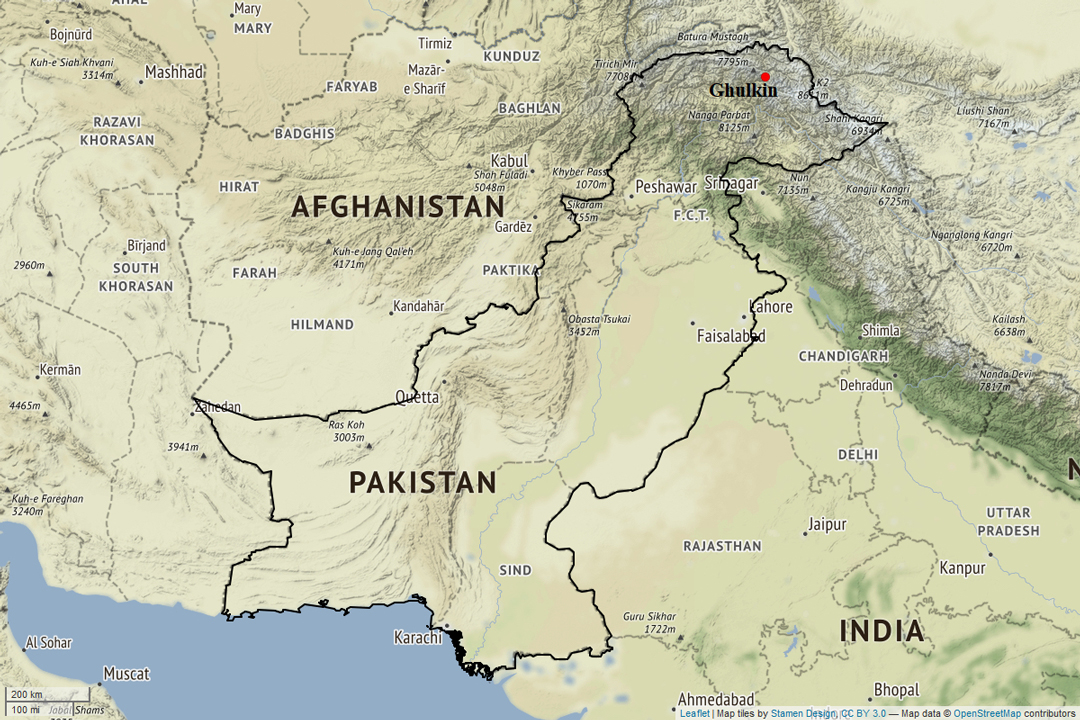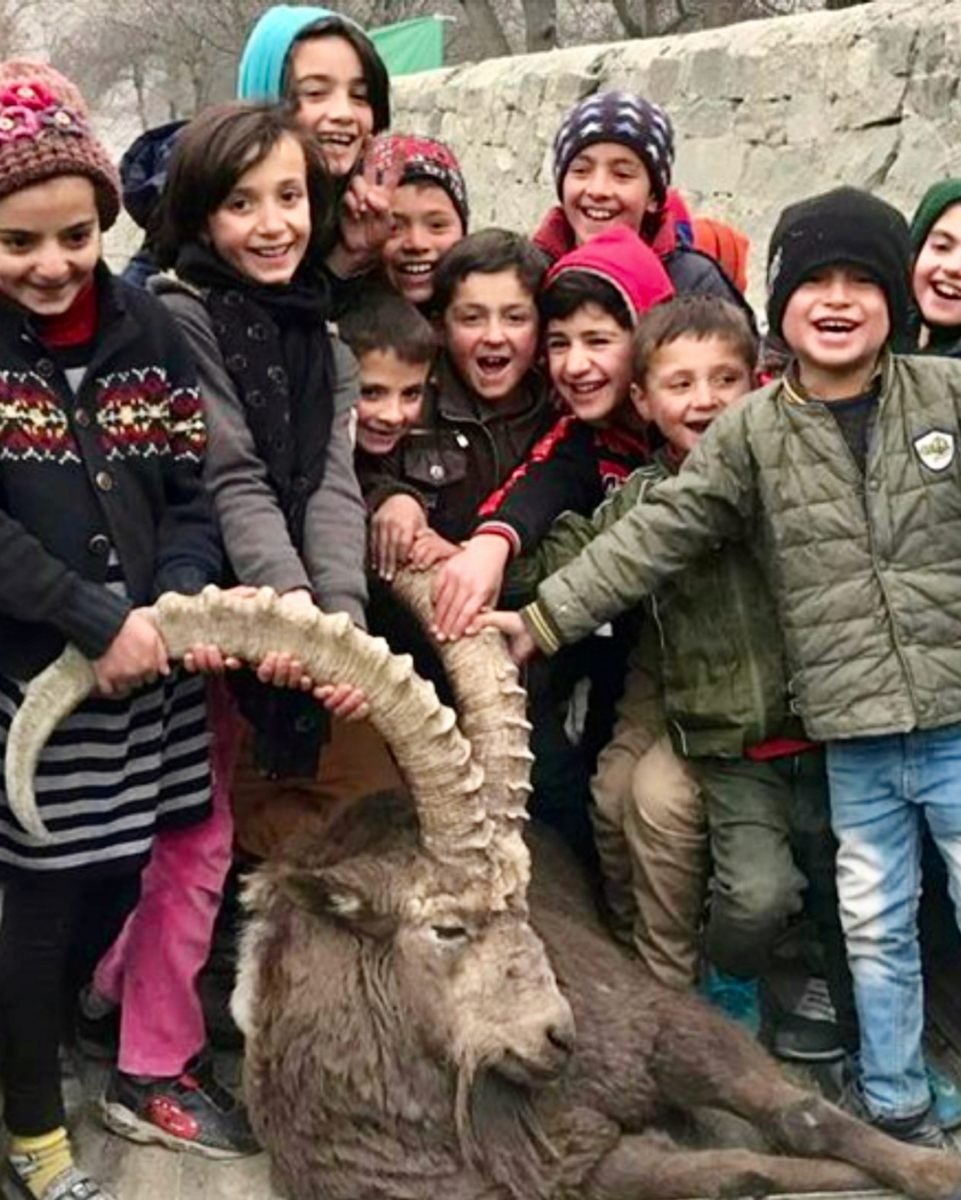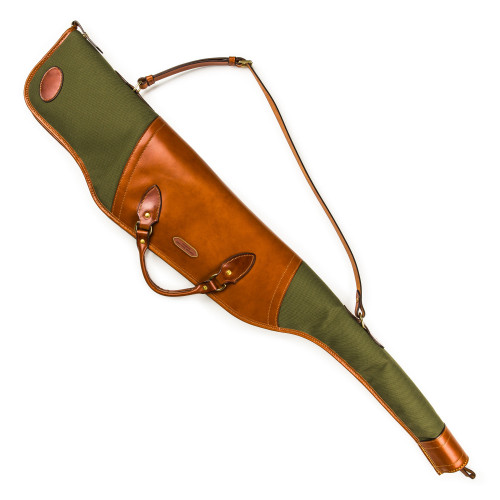The earned funds enable villages to build infrastructure while a new environmental sensibility has reduced human-wildlife conflict and allowed predators such as snow leopards to thrive again. Westley Richards brings you this story with the help of our friends at Conservation Frontlines.
Muhammad Shahim Khan is a 22-year-old native of the Gilgit-Baltistan region of northern Pakistan. Shahim’s grandfather, Mirzada Shah Khan, was the first to outfit foreign hunters in Gilgit-Baltistan, and the family business, Himalaya Nature Tours, founded in 1986, continues today; it also offers hiking and trekking. At first Shahim was reluctant to join the company. He repeatedly asked his father, who is now the manager, how he could facilitate the killing of such magnificent animals as the ibex and markhor. These ungulates, a type of wild goat that inhabits the high mountains, have horns that can grow up to five feet long. Shahim believed that since these animals were endangered, hunting was making the situation worse. “Just come into the business and you will see for yourself,” his father replied.
 A markhor ram, a male, descending a snowy hillside in Pakistan.
A markhor ram, a male, descending a snowy hillside in Pakistan.So, at the age of 14, Shahim did just that and what he saw, he says, changed his opinion and his life. He traveled to rural communities in remote parts of Pakistan. He saw the tangible benefits of hunting income—cash injected into local economies by international visitors who visit Pakistan to hunt. He asked community members if they were happy with Pakistan’s hunting program, or did they feel forced by the government to accept hunting on their lands?
“The communities can make schools, they make roads, they make water channels, they receive electricity all year-round. These hunts benefit the whole community, and that is why the whole community comes together to protect these animals—because they know the animals’ worth,” Shahim now says.
Not only has hunting tourism increased the incomes and opportunities of rural people in Pakistan, but it is also responsible for the revival of several imperiled species throughout the country. Hunting created value for wildlife such as ibex and markhor, and mountain villages saw the benefits of properly managing these four-legged assets.
The Backstory
In the mid-1980s, Pakistan banned hunting for ibex and markhor. Subsistence hunting by villagers (for meat) and trophy hunting by elites (for the impressive horns) had reduced their populations to dangerously low levels; unregulated harvesting threatened extirpation.
In 1994, the IUCN, International Union for Conservation of Nature, listed the markhor—Pakistan’s national animal, with a country-wide population estimated at around 2,500—as endangered. Research showed that poaching, habitat fragmentation and competition with domestic livestock were largely to blame for the low numbers.
The IUCN, the World Wildlife Fund-Pakistan and local development groups then approached Pakistani conservationists to propose a legal, incentive-based hunting program that would operate at the local level. This would allow the sale of a tightly controlled, limited number of hunting permits for markhor, urial sheep and ibex at premium prices. Buyers, mostly foreign hunters, could keep the horns and hide; local communities would receive the meat and jobs, as well as 80% of the money paid for the hunting permits.
The villages would develop CCAs, community conservation areas—units of land with significant biodiversity and ecological or cultural value, as defined by the IUCN—and then be responsible for their conservation and management. The income from hunting in their CCAs would allow communities to improve their quality of life and incentivize people to protect “their” animals from poachers.
According to Kaiser Khan, a well-known hunting outfitter in Pakistan, at first the idea of bringing in foreigners to hunt these dwindling species confused the government and concerned the locals. But “many prominent tribal leaders, feudal lords and conservationists . . . launched [supporting] campaigns and played important roles in introducing community-based conservation and trophy hunting programs” across Pakistan. Thanks to these efforts, the national government approved ibex hunting in 1993.
In 1997, the 10th Conference of Parties of CITES, the Convention on International Trade in Endangered Species of Wild Fauna and Flora, recognizing the value of this program, approved an annual export quota of four of each of Pakistan’s three markhor species: the Kashmir markhor, Astor markhor and Sulaiman markhor. CITES controls the international movement of plants and animals, and these export quotas—based on bi-annual wildlife censuses—allow foreign hunters to bring home trophies. Provincial wildlife departments and local communities manage the hunting.
Kaiser Khan points out that since the three markhor species are spread across Pakistan, the financial incentives and conservation benefits are distributed across indigenous communities throughout the country as well.
Ultimately, this incentive-based approach to conservation worked. The introduction of sustainable hunting transformed Pakistan’s high-altitude environment by conferring significant monetary value on the animals and giving most of the earned funds directly to villages to invest in water wells, schools, bridges and other vital infrastructure as well as wildlife conservation.
There are now about 50 community-managed hunting areas covering nearly one-third of Gilgit-Baltistan (see map, below), according to a 2021 study published on ScienceDirect.com. And today markhor is one of the most expensive animals on earth to hunt—a single permit fetches upwards of US $135,000. That’s simply for the privilege of hunting one animal, before the costs of travel, outfitting and guiding services, and any shipping and taxidermy of the trophy.
Classification Upgrades
When the program took off and people began to see the benefits of protecting their wildlife, poaching almost vanished. In 2014, as a result of Pakistan’s successful conservation efforts, the US Fish and Wildlife Service removed the markhor from its endangered-species list and reclassified the animal as threatened, thereby allowing hunters to bring certified horns and hides from the program into the United States. Since most of the world’s big-game hunters come from the US, this opened an enormous market for Pakistan.
In 2015, the IUCN also reclassified the markhor, from endangered to near-threatened, meaning that close management is required to prevent the species from becoming threatened again.
Markhor are still listed on its Appendix I by CITES, which keeps the species carefully monitored by national and international conservation groups. Appendix I species are “threatened with extinction” but international trade in them “may take place provided it is authorized by the granting of both an import permit and an export permit.” Pakistan keeps hunting export quotas deliberately low, to reduce the possibility of population declines and keep demand and fees high. Today, according to recent government data, markhor numbers throughout Pakistan have more than doubled since their listing.
As for Pakistan’s other big-game species, annual hunting export quotas are determined by CITES based on a variety of factors, including population numbers, habitat distribution and the vulnerability of the animal. Urial sheep, for example, are listed on CITES Appendix II, meaning the species is not currently endangered, so Pakistan may allow more of them to be hunted each year. Ibex are abundant in Pakistan and are classified as an Appendix III animal, which lets the Pakistani government set its own hunting quotas but still requires export and import permits.
 Pakistan’s forbidding Karakoram Mountains are extremely challenging terrain for hunting and trekking. Jeff Eno photo.
Pakistan’s forbidding Karakoram Mountains are extremely challenging terrain for hunting and trekking. Jeff Eno photo.A Case Study
In March 2020, Jeff Eno, a Canadian hunter with a keen interest in mountain species, traveled to Ghulkin, a small village at about 9,000 feet of elevation in Gilgit-Baltistan, to hunt ibex. The night before his hike into the crags of the Karakoram Range, the mountains that tower over Ghulkin, he sat down with the village headman and a dozen of the local people who would be aiding in his hunt.
Eno ate cookies and drank tea as he admired the horns and photos adorning the walls of the meeting room. He quickly became impressed with how invested each resident of Ghulkin was in the program—this was, he says, unlike any hunting experience he’d ever had. The headman explained the impact of Eno’s hunt: 80% of the fee he’d paid for his ibex tag would go directly to Ghulkin Nature Conservation, the organization created to manage tourism and conservation efforts in the local CCA. The other 20% would go to the government wildlife department to help pay for logistics and conservation programs such as skill-development classes and species monitoring.
The hunting tags—so called because they must be attached to the animals—are auctioned off each year by the Pakistani government to local outfitters. The client then covers the price of the tag plus the outfitter’s costs for guides, porters, scouts, cooks and others involved in creating and supporting the hunt. Each person makes their living from foreign hunters, with jobs that were nonexistent before the CCA program began.
Eno was permitted to shoot a mature ibex ram, a male. As he met with the headman that evening, scouts were already in the mountains, searching for a trophy ibex. The community had every incentive to work with Eno for a successful hunt. Unusually, the very next day Eno had the great fortune to shoot an ibex at around 13,000 feet of elevation, after hours of steep and grueling mountaineering. He returned to Ghulkin that night by headlamp, followed by a team of villagers who carefully carried his ibex around the cliffs. The team’s spirits were as high as the Karakoram peaks.
 The hunting party descends to the village of Ghulkin after a successful ibex stalk. Jeff Eno photo.
The hunting party descends to the village of Ghulkin after a successful ibex stalk. Jeff Eno photo.The next day, the villagers threw a celebration to thank Eno. They presented him with a traditional hat and garland as a token of their gratitude, and the meat from the animal was distributed throughout the community. (Eno sat down with the villagers to eat; ibex, he says, tastes like mild mutton.) Eno left Ghulkin with a deep sense of appreciation for a successful experience and pride in the impact that his hunt would have on the community and on the conservation of wildlife in Pakistan.
On The Ground
When hunting tourism was introduced to Gilgit-Baltistan in the 1990s, the village of Ghulkin was one of the pioneering participants. GLAD, Ghulkin Nature Conservation, was formed in 1993 to manage the local wildlife tourism. It took four years for Ghulkin to welcome its first hunter. Since then, foreign hunters have increasingly visited Ghulkin, and tourism income has soared. The money has been used to fund an English-language school (about 95% of the population now speaks English); the Clean Drinking Water Project, which now supplies all of Ghulkin's 200-some households; the construction of a prayer hall, an IT center, homes in the village and pasture for livestock that reduces conflict with wildlife. Villagers can now apply for small business grants. About 30% of GLAD’s hunting income is reinvested in the environment to conserve wildlife habitat.
 The village of Ghulkin is in Gilgit-Baltistan, a mountainous territory administered by Pakistan and part of the disputed (between Pakistan, India and China) Kashmir Region.
The village of Ghulkin is in Gilgit-Baltistan, a mountainous territory administered by Pakistan and part of the disputed (between Pakistan, India and China) Kashmir Region.Gilgit-Baltistan receives four of Pakistan’s allotted 12 markhor permits each year. From 1995 through 2020, the region earned nearly US $5 million in revenue from markhor permits alone, of which (according to Gilgit-Baltistan’s Department of Forests, Parks and Wildlife) $4.3 million has gone to community projects and environmental development.
Incentives Bring Results
Markhor, ibex and urial sheep populations in Gilgit-Baltistan have increased steadily and local people report seeing more of each species each year since the hunting program began. With their revival, carnivores such as the snow leopard, wolf and lynx also have increased in numbers due to the conservation of habitat and prey, according to a study published in Global Ecology and Conservation. All are seen regularly now by villagers, which was unheard of a few decades ago.
 Conserving its prey species has allowed the snow leopard to proliferate as well. Villagers say they now see the big cats routinely.
Conserving its prey species has allowed the snow leopard to proliferate as well. Villagers say they now see the big cats routinely.As well, snow leopard predation of livestock is declining with the increase in natural prey and, in turn, the cats’ relationship with villagers is improving. Along with the markhor, the IUCN has upgraded the snow leopard from endangered to near-threatened, and countries across the world recognize Pakistan for its conservation achievements.
Shahim Khan is now a proud member of his grandfather’s business, facilitating hunts that helped transform his community right before his eyes. He says his favorite aspect of the hunting program is how poachers have gone from freely and illegally killing game to now safeguarding them with their lives. He is also impressed by the unity the program has created between different sects of people.
“When I joined my father on my first hunt, little did I know that one day I would not just realize the impacts of this program but be a part of it myself,” he said. “I never expected to see the way that everyone came together for one common mission, standing shoulder to shoulder.”
Gentry Hale is an environmental journalist based in Missoula, Montana. She studied environmental sustainability at the University of Utah and journalism at the University of Montana. Her interests include environmental science, sustainability, land management, and natural-resource and wildlife conservation. Her article was commissioned by the Conservation Frontlines Foundation.
The Explora Blog is the world’s premier online journal for field sports enthusiasts, outdoor adventurers, conservationists and admirers of bespoke gunmaking, fine leather goods and timeless safari clothes. Each month Westley Richards publishes up to 8 blog posts on a range of topics with an avid readership totalling 500,000+ page views per year.
Blog post topics include: Finished custom rifles and bespoke guns leaving the Westley Richards factory; examples of heritage firearms with unique designs and celebrated owners like James Sutherland and Frederick Courtenay Selous; the latest from the company pre-owned guns and rifles collection; interviews with the makers from the gun and leather factory; new season safari wear and country clothing; recent additions to our luxury travel bags and sporting leather goodsrange; time well spent out in the field; latest news in the sporting world; and key international conservation stories.





















neil mcveigh on March 20, 2023 at 5:15 am
Fantastic article!Everybody should down-load this to their phone and carry with them.The next time an anti-hunter seeks the moral high ground,insist they read this before debating the merits of our wonderful sport.